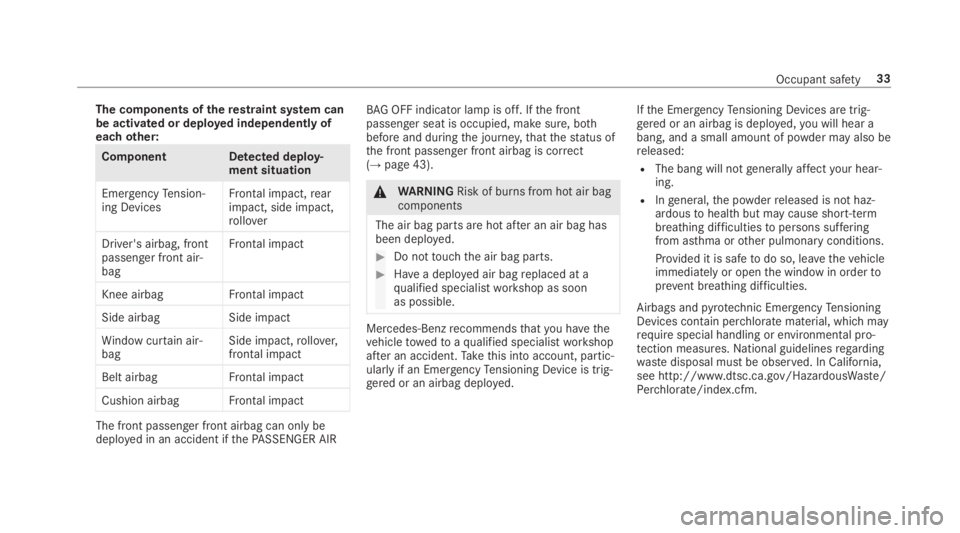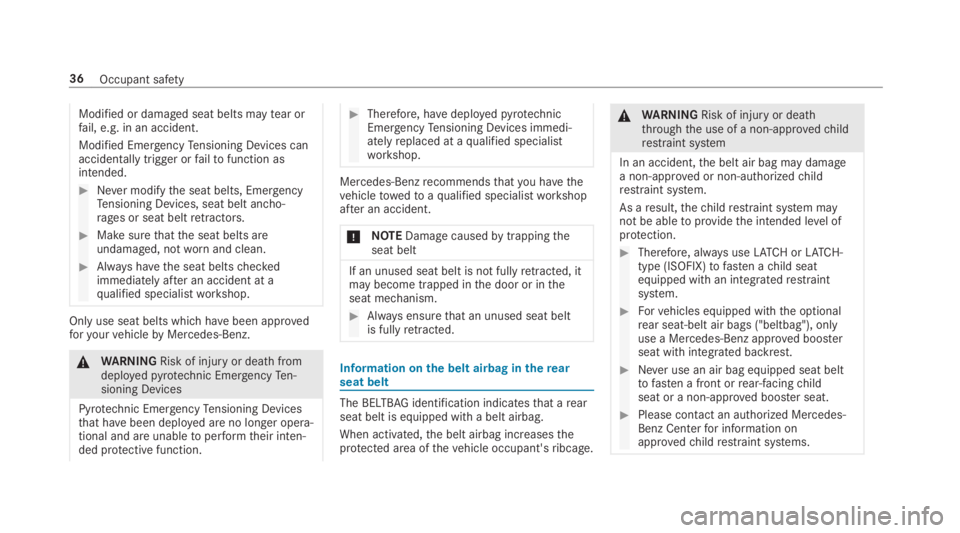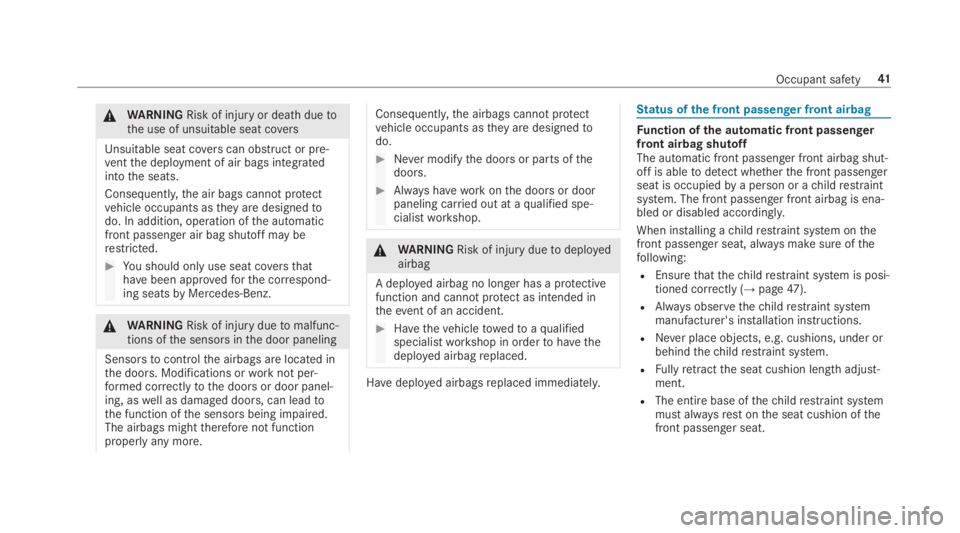2019 MERCEDES-BENZ S CLASS airbag
[x] Cancel search: airbagPage 35 of 578

The components oftherestraint system canbe activated or deployed independently ofeachother:
Component Detected deploy‐ment situation
EmergencyTension‐ing DevicesFrontal impact,rearimpact, side impact,rollover
Driver's airbag, frontpassenger front air‐bag
Frontal impact
Knee airbagFrontal impact
Side airbagSide impact
Window curtain air‐bagSide impact,rollover,frontal impact
Belt airbagFrontal impact
Cushion airbagFrontal impact
The front passenger front airbag can only bedeployed in an accident ifthePASSENGER AIR
BAG OFF indicator lamp is off. Ifthe frontpassenger seat is occupied, make sure, bothbefore and duringthe journey,thatthestatus ofthe front passenger front airbag is correct(→page43).
&WARNINGRisk of burns from hot air bagcomponents
The air bag parts are hot after an air bag hasbeen deployed.
#Do nottouchthe air bag parts.
#Havea deployed air bagreplaced at aqualified specialistworkshop as soonas possible.
Mercedes-Benzrecommendsthatyou havethevehicletowedtoaqualified specialistworkshopafter an accident.Takethis into account, partic‐ularly if an EmergencyTensioning Device is trig‐gered or an airbag deployed.
Ifthe EmergencyTensioning Devices are trig‐gered or an airbag is deployed,you will hear abang, and a small amount of powder may also bereleased:
RThe bang will notgenerally affectyour hear‐ing.
RIngeneral,the powderreleased is not haz‐ardoustohealth but may cause short-termbreathing difficultiestopersons sufferingfrom asthma orother pulmonary conditions.
Provided it is safetodo so, leavethevehicleimmediately or openthe window in ordertoprevent breathing difficulties.
Airbags andpyrotechnic EmergencyTensioningDevices contain perchlorate material, which mayrequire special handling or environmental pro‐tection measures.National guidelinesregardingwaste disposal must be observed. In California,see http://www.dtsc.ca.gov/HazardousWaste/Perchlorate/index.cfm.
Occupant safety33
Page 38 of 578

Modified or damaged seat belts maytear orfail, e.g. in an accident.
Modified EmergencyTensioning Devices canaccidentally trigger orfailtofunction asintended.
#Never modifythe seat belts, EmergencyTensioning Devices, seat belt ancho‐rages or seat beltretractors.
#Makesurethatthe seat belts areundamaged, notwornand clean.
#Always havethe seat beltscheckedimmediately after an accident at aqualified specialistworkshop.
Only use seat belts which havebeen approvedforyourvehiclebyMercedes-Benz.
&WARNINGRisk of injuryor death fromdeployedpyrotechnic EmergencyTen‐sioning Devices
Pyrotechnic EmergencyTensioning Devicesthat havebeen deployed are no longer opera‐tional and are unabletoperformtheir inten‐ded protective function.
#Therefore, havedeployedpyrotechnicEmergencyTensioning Devices immedi‐atelyreplaced at aqualified specialistworkshop.
Mercedes-Benzrecommendsthatyou havethevehicletowedtoaqualified specialistworkshopafter an accident.
*NOTEDamagecausedbytrappingtheseat belt
If an unused seat belt is not fullyretracted, itmay become trapped inthe door or intheseat mechanism.
#Always ensurethat an unused seat beltis fullyretracted.
Information onthe belt airbag intherearseat belt
The BELTBAGidentification indicatesthat arearseat belt is equipped with a belt airbag.
When activated,the belt airbag increasestheprotected area ofthevehicle occupant'sribcage.
&WARNINGRisk of injuryor deaththroughthe use of a non-approvedchildrestraint system
In an accident,the belt air bag may damagea non-approved or non-authorizedchildrestraint system.
As aresult,thechildrestraint system maynot be abletoprovidethe intended level ofprotection.
#Therefore, always useLATCH orLATCH-type (ISOFIX)tofasten achild seatequipped with an integratedrestraintsystem.
#Forvehicles equipped withthe optionalrear seat-belt air bags ("beltbag"), onlyuse a Mercedes-Benz approved boosterseat with integrated backrest.
#Never use an air bag equipped seat belttofasten a front orrear-facingchildseat or a non-approved booster seat.
#Please contact an authorized Mercedes-Benz Centerfor information onapprovedchildrestraint systems.
36Occupant safety
Page 39 of 578

Fastening and adjustingthe seat belts
Ifthe seat belt is pulledquickly or sharply,theseat beltretractor locks. The seat beltstrap can‐not be pulled out any further.
#Always engage seat belttongue2oftheseat belt into seat belt buckle1ofthe cor‐responding seat.
#Press and holdthe seat belt outletreleaseand slide seat belt outlet3intothe desiredposition.
#Let go ofthe seat belt outletrelease andensurethat seat belt outlet3locksintoposition.
Vehicles with automatic front passengerfront airbag shutoff:
*NOTEDeployment ofthe EmergencyTensioning Device and side air bag whenthe front passenger seat is unoccupied
Ifthe seat belttongue is engaged inthe seatbelt buckle ofthe unoccupied frontpassenger seat,the EmergencyTensioningDevice andthe side air bag may also deployintheevent of an accident along withothersystems.
#Only one person should use each seatbelt at any one time.
Vehicles without automatic front passengerfront airbag shutoff:
*NOTEDeployment ofthe EmergencyTensioning Device whenthe front-passenger seat is unoccupied
Ifthe seat belttongue is engaged inthe seatbelt buckle ofthe unoccupied front-passenger seat,the EmergencyTensioningDevice may also deployintheevent of anaccident along withother systems.
#Only one person should use each seatbelt at any one time.
Seat belt adjustment function
Vehicles with PRE-SAFE®:Ifthe front seat beltis not pulled tight acrossyour body,the seat beltadjustment may automatically apply a certaintighteningforce. Do not holdthe seat belt tightlywhile it is adjusting.
You can activate and deactivatethe seat beltadjustment function usingthe multimedia sys‐tem (→page 38).
Occupant safety37
Page 41 of 578

Potential protection from each airbag:
AirbagPotential protectionfor…
Knee airbag Thigh, knee and lower leg
Driver's airbag,front passengerfront airbag
Head andribcage
Window curtainairbagHead
Side impact air‐bagRibcage, also pelvisforfront seat occupants
The front passenger front airbag can only bedeployed in an accident ifthePASSENGER AIRBAG OFF indicator lamp is off. Ifthe frontpassenger seat is occupied, make sure, bothbefore and duringthe journey,thatthestatus ofthe front passenger front airbag is correct(→page43).
*NOTEImportant pointstoremember ifthe front passenger seat is unoccupied
In an accident,the components oftherestraint system may deploy unnecessarilyonthe front passenger side if:
RThere are heavy objects onthe frontpassenger seat.
RThe seat belttongue is engaged intheseat belt buckle ofthe front passengerseat andthe front passenger seat isunoccupied.
#Stowobjects in a suitable place.
#Only one person should use each seatbelt at any one time.
Cushionbag intherecliningrear seatIfthe seat backrest inclination is significant,thecushionbag provides additional occupant protec‐tion intheevent of a frontal impact. When acti‐vated,the cushionbag deploysunderthe seatcushion. This helps preventthevehicle occupantfrom slipping offthe seat cushion.
Ifyou install achildrestraint system ontherecliningrear seat, always observethe additionalnotes (→page 48).
Protectionbythe airbags
Depending onthe accident situation, an airbagmay supplementthe protection offeredbya cor‐rectlyfastened seat belt.
&WARNINGRisk of injuryor death duetoincorrect seat position
Ifyou deviate fromthe correct seat position,the air bag cannotperformits intended pro‐tective function and deployment mayevencause further injuries.
Toavoid hazardous situations, always makesurethat allvehicle occupants:
RHavetheir seat beltfastened correctly,including pregnantwomen.
RAre seated properlyandthat distancetothe air bags is as largeas possible.
RObservethefollowing information.
Occupant safety39
Page 42 of 578

#Always make surethatthere are noobjects betweenthe air bag andthevehicle occupant.
Toavoidtherisksresulting fromthe deploymentof an airbag, eachvehicle occupant mustobservethefollowing information:
RBeforestartingyour journey,adjustyour seatcorrectly;the driver's seat and front-passenger seat should be moved asfar backas possible.
When doing so, always observethe informa‐tion onthe correct driver's seat position(→page92).
ROnly holdthesteering wheelbythesteeringwheelrim. This allowsthe airbagtobe fullydeployed.
RAlways lean againstthe seat backrest whenthevehicle is in motion. Do not leanforwardsor againstthe door or side window.You mayotherwise be inthe deployment area oftheairbags.
RAlwayskeepyourfeetonthefloor. Do notputyourfeetonthe cockpit,forexample.
Yourfeetmayotherwise be inthe deploy‐ment area ofthe airbag.
RIfchildren are traveling inthevehicle,observethe additional notes (→page 48).
RAlwaysstowand secure objects correctly.
Objects inthevehicle interior may prevent anairbag from functioning correctly. Eachvehicleoccupant must always make sure ofthefollow‐ing:
RThere are no people, animals or objectsbetweenthevehicle occupants and an air‐bag.
RThere are no objects betweenthe seat, doorand door pillar (B-pillar).
RThere are no hard objects, e.g. coat hangers,hanging onthe grab handles or coat hooks.
RThere are no accessory parts, such as PNDs(PersonalNavigation Devices), mobilephones or cup holders attachedtothevehi‐cle withinthe deployment area of an airbag,e.g. onthe cockpit, on doors, side windowsor side paneling.
In addition, no connecting cable,tensioningstrap orretainingstrap may beroutedthrough or attached inthe deployment areaof an airbag. Always observethe accessorymanufacturer's installation instructions, inparticularthe information on suitable placesfor installation.
RThere are no heavy, sharp-edged or fragileobjects inthe pockets ofyour clothing.Storesuch objects in a suitable place.
Limited protection from airbags
&WARNINGRisk of injuryduetomodifi‐cationstothe airbag cover
Ifyou modifythe cover of an airbag or affixobjects such asstickerstoit,the airbag mayno longer function correctly.
#Never modifythe cover of an airbag anddo not affix objectstoit.
The installation location of an airbag is identifiedbythe AIRBAGsymbol (→page 38).
40Occupant safety
Page 43 of 578

&WARNINGRisk of injuryor death duetothe use of unsuitable seat covers
Unsuitable seat coverscan obstruct or pre‐ventthe deployment of air bags integratedintothe seats.
Consequently,the air bags cannotprotectvehicle occupants astheyare designedtodo. In addition, operation ofthe automaticfront passenger air bag shutoff may berestricted.
#You should onlyuse seat coversthathavebeen approvedforthe correspond‐ing seatsbyMercedes-Benz.
&WARNINGRisk of injuryduetomalfunc‐tions ofthe sensors inthe door paneling
Sensorstocontrolthe airbags are located inthe doors. Modifications orworknot per‐formed correctlytothe doors or door panel‐ing, aswell as damaged doors, can leadtothe function ofthe sensors being impaired.The airbags mighttherefore not functionproperlyany more.
Consequently,the airbags cannotprotectvehicle occupants astheyare designedtodo.
#Never modifythe doors or parts ofthedoors.
#Always haveworkonthe doors or doorpaneling carried out at aqualified spe‐cialistworkshop.
&WARNINGRisk of injuryduetodeployedairbag
A deployed airbag no longer has a protectivefunction and cannotprotect as intended intheevent of an accident.
#Havethevehicletowedtoaqualifiedspecialistworkshop in ordertohavethedeployed airbagreplaced.
Havedeployed airbagsreplaced immediately.
Status ofthe front passenger front airbag
Function ofthe automatic front passengerfront airbag shutoffThe automatic front passenger front airbag shut‐off is abletodetect whetherthe front passengerseat is occupiedbya person or achildrestraintsystem. The front passenger front airbag is ena‐bled or disabled accordingly.
When installing achildrestraint system onthefront passenger seat, always make sure ofthefollowing:
REnsurethatthechildrestraint system is posi‐tioned correctly (→page47).
RAlways observethechildrestraint systemmanufacturer's installation instructions.
RNever place objects, e.g. cushions, under orbehindthechildrestraint system.
RFullyretractthe seat cushion length adjust‐ment.
RThe entire base ofthechildrestraint systemmust alwaysrestonthe seat cushion ofthefront passenger seat.
Occupant safety41
Page 44 of 578

RThe backrest oftheforward-facingchildrestraint system must lie asflat as possibleagainstthe backrest ofthe front passengerseat.
RThechildrestraint system must nottouchtheroof or be put understrainbythe headrestraints.Adjustthe seat backrest inclina‐tion andthe headrestraint setting accord‐ingly.
&WARNINGRisk of injuryor death duetoobjects betweenthe sitting surface andthechildrestraint system
Objects betweenthe sitting surface andthechildrestraint system could affectthe func‐tion ofthe automatic front passenger airbagshutoff.
This couldresult inthe front passenger air‐bag not functioning as intended during anaccident.
#Do not place any objects betweenthesitting surface andthechildrestraintsystem.
#The entire base ofthechildrestraintsystem must alwaysrestonthe sittingsurface ofthe front passenger seat.
#The backrest oftheforward-facingchildrestraint system must, asfar as possi‐ble, beresting onthe seat backrest ofthe front passenger seat.
#Always comply withthechildrestraintsystem manufacturer's installationinstructions.
A person onthe front passenger seat mustobservethefollowing information:
RFasten seat belts correctly (→page34).
RSit in an almost upright seat position withtheir back againstthe seat backrest.
RSit withtheirfeetresting onthefloor, if pos‐sible.
The front passenger front airbag mayotherwisebe disabledbymistake,forexample inthefol‐lowing situations:
RThe front passenger transferstheirweightbysupportingthemselves on avehicle armrest.
RThe front passenger sits in such awaythattheirweight israised fromthe sitting sur‐face.
&WARNINGRisk of injuryor death duetodeactivated front passenger airbag
IfthePASSENGER AIRBAG OFF indicatorlamp is lit,the front passenger airbag is disa‐bled. It will not be deployed intheevent ofan accident and cannotperformits intendedprotective function.
A person inthe front passenger seat couldthen,forexample, come into contact withthevehicle interior, especially ifthe person issittingtoo closetothe cockpit.
Ifthe front passenger seat is occupied,always ensurethat:
RThe classification ofthe person inthefront passenger seat is correct andthefront passenger airbag is enabled or disa‐bled in accordance withthe person inthefront passenger seat.
42Occupant safety
Page 45 of 578

RThe front passenger seat has been movedasfar back as possible.
RThe person is seated correctly.
#Ensure, bothbefore and duringthe jour‐ney,thatthestatus ofthe frontpassenger airbag is correct.
Ifthe front passenger seat is occupied,the clas‐sification ofthe person orchildrestraint systemonthe front passenger seattakes place afterthefront passenger front airbag shutoff self-test.ThePASSENGER AIRBAG indicator lamps dis‐playthestatus ofthe front passenger front air‐bag.
Always observethe notes onthe function ofthePASSENGER AIRBAG indicator lamps(→page 43).
Function ofthePASSENGER AIRBAG indica‐tor lamps
Self-testof automatic front passenger frontairbag shutoffWhenthe ignition is switched on, a self-test isperformed during whichthe twoPASSENGERAIRBAG ON and OFF indicator lamps light upsimultaneously.
Thestatus ofthe front passenger front airbag isdisplayed afterthe self-test:
RPASSENGER AIRBAG ON lights upfor60 seconds, subsequently bothindicatorlamps are off (PASSENGER AIRBAG ON andOFF):the front passenger front airbag is abletodeploy intheevent of an accident.
RPASSENGER AIRBAG OFF lights up continu‐ously:the front passenger front airbag is dis‐abled. It willthen not be deployed intheevent of an accident.
IfthePASSENGER AIRBAG ON indicator lamp isoff, onlythePASSENGER AIRBAG OFF indicatorlamp shows thestatus ofthe front passengerfront airbag. ThePASSENGER AIRBAG OFF indi‐cator lamp may be lit continuously or be off.
IfthePASSENGER AIRBAG OFF indicator lampandthe�urestraint systemwarning lamplight up simultaneously,the front passenger seatmay not be used. Also inthis case, do not installachildrestraint system onthe front passengerseat. Haveautomatic front passenger front air‐bag shutoffchecked andrepaired immediately ataqualified specialistworkshop.
Occupant safety43